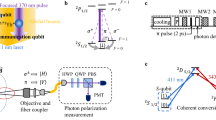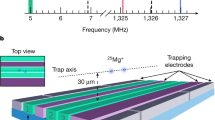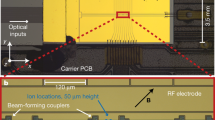Abstract
Trapped ions constitute one of the most promising systems for implementing quantum computing and networking1,2. For large-scale ion-trap-based quantum computers and networks, it is critical to have two types of qubit: one for computation and storage, and another for auxiliary operations such as qubit detection3, sympathetic cooling4,5,6,7 and entanglement generation through photon links8,9. Although the two qubit types can be implemented using two different ion species3,10,11,12,13, this approach introduces substantial complexity into creating and controlling each qubit type14,15. Here we resolve these challenges by implementing two coherently convertible qubit types using one ion species. We encode the qubits into two pairs of clock states of the 171Yb+ ions, and achieve microsecond-level conversion rates between the two types with one-way fidelities of 99.5%. We further demonstrate that operations on one qubit type, including sympathetic laser cooling, single-qubit gates and qubit detection, have crosstalk errors less than 0.06% on the other type, which is below the best-known error threshold of ~1% for fault-tolerant quantum computing using the surface code1,16. Our work establishes the feasibility and advantages of using coherently convertible dual-type qubits with the same ion species for large-scale quantum computing and networking.
This is a preview of subscription content, access via your institution
Access options
Access Nature and 54 other Nature Portfolio journals
Get Nature+, our best-value online-access subscription
$29.99 / 30 days
cancel any time
Subscribe to this journal
Receive 12 print issues and online access
$209.00 per year
only $17.42 per issue
Buy this article
- Purchase on Springer Link
- Instant access to full article PDF
Prices may be subject to local taxes which are calculated during checkout




Similar content being viewed by others
Data availability
The data that support the findings of this study are available from the authors upon request. Source data are provided with this Paper.
References
Nielsen, M. & Chuang, I. Quantum Computation and Quantum Information 10th anniversary edn (Cambridge Univ. Press, 2010).
Monroe, C. & Kim, J. Scaling the ion trap quantum processor. Science 339, 1164–1169 (2013).
Negnevitsky, V. et al. Repeated multi-qubit readout and feedback with a mixed-species trapped-ion register. Nature 563, 527–531 (2018).
Rohde, H. et al. Sympathetic ground-state cooling and coherent manipulation with two-ion crystals. J. Opt. B Quantum Semiclassical Opt. 3, S34–S41 (2001).
Blinov, B. B. et al. Sympathetic cooling of trapped Cd+ isotopes. Phys. Rev. A 65, 040304 (2002).
Barrett, M. D. et al. Sympathetic cooling of 9Be+ and 24Mg+ for quantum logic. Phys. Rev. A 68, 042302 (2003).
Home, J. P. et al. Memory coherence of a sympathetically cooled trapped-ion qubit. Phys. Rev. A 79, 050305 (2009).
Duan, L.-M. & Monroe, C. Colloquium: Quantum networks with trapped ions. Rev. Mod. Phys. 82, 1209–1224 (2010).
Hucul, D. et al. Modular entanglement of atomic qubits using photons and phonons. Nat. Phys. 11, 37–42 (2015).
Tan, T. R. et al. Multi-element logic gates for trapped-ion qubits. Nature 528, 380–383 (2015).
Inlek, I. V., Crocker, C., Lichtman, M., Sosnova, K. & Monroe, C. Multispecies trapped-ion node for quantum networking. Phys. Rev. Lett. 118, 250502 (2017).
Bruzewicz, C., McConnell, R., Stuart, J., Sage, J. & Chiaverini, J. Dual-species, multi-qubit logic primitives for Ca+/Sr+ trapped-ion crystals. npj Quantum Inf. 5, 102 (2019).
Wan, Y. et al. Quantum gate teleportation between separated qubits in a trapped-ion processor. Science 364, 875–878 (2019).
Sosnova, K., Carter, A. & Monroe, C. Character of motional modes for entanglement and sympathetic cooling of mixed-species trapped-ion chains. Phys. Rev. A 103, 012610 (2021).
Lin, G.-D. & Duan, L.-M. Sympathetic cooling in a large ion crystal. Quantum Inf. Process. 15, 5299–5313 (2016).
Campbell, E. T., Terhal, B. M. & Vuillot, C. Roads towards fault-tolerant universal quantum computation. Nature 549, 172–179 (2017).
Gottesman, D. Theory of fault-tolerant quantum computation. Phys. Rev. A 57, 127–137 (1998).
Duan, L.-M., Blinov, B. B., Moehring, D. L. & Monroe, C. Scalable trapped ion quantum computation with a probabilistic ion-photon mapping. Quantum Info Comput. 4, 165–173 (2004).
Monroe, C. et al. Large-scale modular quantum-computer architecture with atomic memory and photonic interconnects. Phys. Rev. A 89, 022317 (2014).
Zhu, S.-L., Monroe, C. & Duan, L.-M. Trapped ion quantum computation with transverse phonon modes. Phys. Rev. Lett. 97, 050505 (2006).
Lin, G.-D. et al. Large-scale quantum computation in an anharmonic linear ion trap. Europhys. Lett. 86, 60004 (2009).
Taylor, P., Roberts, M., Barwood, G. P. & Gill, P. Combined optical-infrared single-ion frequency standard. Opt. Lett. 23, 298–300 (1998).
Leibfried, D., Blatt, R., Monroe, C. & Wineland, D. Quantum dynamics of single trapped ions. Rev. Mod. Phys. 75, 281–324 (2003).
Roman, C., Ransford, A., Ip, M. & Campbell, W. C. Coherent control for qubit state readout. N. J. Phys. 22, 073038 (2020).
Edmunds, C. L. et al. Scalable hyperfine qubit state detection via electron shelving in the 2D5/2 and 2F7/2 manifolds in 171Yb+. Phys. Rev. A 104, 012606 (2021).
Christensen, J. E., Hucul, D., Campbell, W. C. & Hudson, E. R. High-fidelity manipulation of a qubit enabled by a manufactured nucleus. npj Quantum Inf. 6, 35 (2020).
Barreiro, J. T. et al. An open-system quantum simulator with trapped ions. Nature 470, 486–491 (2011).
Monz, T. et al. Realization of a scalable Shor algorithm. Science 351, 1068–1070 (2016).
Piltz, C., Sriarunothai, T., Ivanov, S. S., Wölk, S. & Wunderlich, C. Versatile microwave-driven trapped ion spin system for quantum information processing. Sci. Adv. 2, e1600093 (2016).
Olmschenk, S. et al. Manipulation and detection of a trapped Yb+ hyperfine qubit. Phys. Rev. A 76, 052314 (2007).
Wootters, W. K. & Fields, B. D. Optimal state-determination by mutually unbiased measurements. Ann. Phys. 191, 363–381 (1989).
Klappenecker, A. & Rotteler, M. Mutually unbiased bases are complex projective 2-designs. In Proc. International Symposium on Information Theory, 2005 1740–1744 (IEEE, 2005).
Choi, T. et al. Optimal quantum control of multimode couplings between trapped ion qubits for scalable entanglement. Phys. Rev. Lett. 112, 190502 (2014).
Brown, K. R., Harrow, A. W. & Chuang, I. L. Arbitrarily accurate composite pulse sequences. Phys. Rev. A 70, 052318 (2004).
Magesan, E., Gambetta, J. M. & Emerson, J. Scalable and robust randomized benchmarking of quantum processes. Phys. Rev. Lett. 106, 180504 (2011).
Feng, L. et al. Efficient ground-state cooling of large trapped-ion chains with an electromagnetically-induced-transparency tripod scheme. Phys. Rev. Lett. 125, 053001 (2020).
Acknowledgements
This work was supported by the Tsinghua University Initiative Scientific Research Program and the Ministry of Education of China through its fund to the IIIS.
Author information
Authors and Affiliations
Contributions
L.-M.D. proposed and supervised the experiment. H.-X.Y., J.-Y.M., Y.W., M.-M.C., W.-X.G., Y.-Y.H., L.F., Y.-K.W. and Z.-C.Z. carried out the experiment. H.-X.Y., J.-Y.M., Y.-K.W. and L.-M.D. wrote the manuscript.
Corresponding author
Ethics declarations
Competing interests
The authors declare no competing interests.
Peer review
Peer review information
Nature Physics thanks Cornelius Hempel and Christof Wunderlich for their contribution to the peer review of this work.
Additional information
Publisher’s note Springer Nature remains neutral with regard to jurisdictional claims in published maps and institutional affiliations.
Extended data
Extended Data Fig. 1 Detailed time sequence for measuring the crosstalk of S-qubit operations on the F-qubit.
Detailed time sequence for measuring the crosstalk of S-qubit operations on the F-qubit. a, Time sequence for the S-qubit and the F-qubit (which also starts from an S-qubit). During the verification step of the F-qubit, resonant 370-nm laser is applied, so the S-qubit needs to be reinitialized after that. b, Specific S-qubit operations for Fig. 3b to measure crosstalk errors of Raman Rabi oscillation using 355-nm laser. c, Specific S-qubit operations for Fig. 3c to measure crosstalk errors of preparation and detection of \(\left|0\right\rangle\). d, Specific S-qubit operations for Fig. 3d to measure crosstalk errors of preparation and detection of \(\left|1\right\rangle\).
Extended Data Fig. 2 Carrier Rabi oscillation of the 411-nm laser and 3,432-nm laser.
Carrier Rabi oscillation of a, the 411-nm laser and b, 3,432-nm laser. The 411-nm laser has an optical power of about 0.8 mW and a beam diameter of about 8 µm, which generates a Rabi frequency of about 2π × 859.4 kHz. The 3,432-nm laser has an optical power of about 0.5 mW and a beam diameter of about 73 µm, which gives a Rabi frequency of about 2π × 1.2 MHz.
Extended Data Fig. 3 Randomized benchmarking of the microwave-driven single-qubit gates.
Randomized benchmarking of the microwave-driven single-qubit gates for a, the S-qubit and b, the F-qubit. The average gate fidelity is (99.98 ± 0.04)% for the S-qubit and (99.99 ± 0.04)% for the F-qubit.
Extended Data Fig. 4 Carrier Rabi oscillation of 411-nm laser after 500 µs sympathetic cooling.
Carrier Rabi oscillation of 411-nm laser after 500 µs sympathetic cooling. The fitted effective temperature is (9.2 ± 0.2) mK.
Source data
Source Data Fig. 2
Statistical source data.
Source Data Fig. 3
Statistical source data.
Source Data Fig. 4
Statistical source data.
Source Data Extended Data Fig. 2
Statistical source data.
Source Data Extended Data Fig. 3
Statistical source data.
Source Data Extended Data Fig. 4
Statistical source data.
Rights and permissions
About this article
Cite this article
Yang, HX., Ma, JY., Wu, YK. et al. Realizing coherently convertible dual-type qubits with the same ion species. Nat. Phys. 18, 1058–1061 (2022). https://doi.org/10.1038/s41567-022-01661-5
Received:
Accepted:
Published:
Issue Date:
DOI: https://doi.org/10.1038/s41567-022-01661-5
This article is cited by
-
Realization of a crosstalk-avoided quantum network node using dual-type qubits of the same ion species
Nature Communications (2024)
-
High-fidelity gates and mid-circuit erasure conversion in an atomic qubit
Nature (2023)
-
Noisy intermediate-scale quantum computers
Frontiers of Physics (2023)
-
Two qubits for the price of one ion
Nature Physics (2022)



